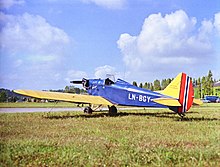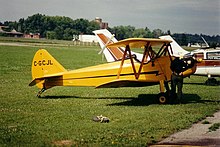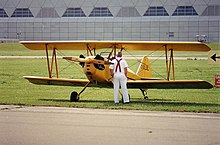|
Bowers Fly Baby
   The Bowers Fly Baby is a homebuilt, single-seat, open-cockpit, wood and fabric low-wing monoplane that was designed by famed United States aircraft designer and Boeing historian, Peter M. Bowers.[1] DevelopmentThe prototype Fly Baby first flew in 1962, becoming the winner of the Experimental Aircraft Association's 1962 design competition.[1][2] Variants include a biplane version called the Bowers Bi-Baby or Fly Baby 1-B,[1][2] a floatplane version,[1] and several dual-cockpit designs by various builders.[2] Bowers also designed a side-by-side two-seat version he called Namu II, but few examples have been built.[2]
DesignTo win the 1962 Experimental Aircraft Association (EAA) Design Contest, Bowers designed the small plane to meet EAA's criteria for a low-cost, folding-wing airplane that was easy to build and fly, and could be towed or trailered.[1] The Fly Baby was designed to be a very simple aircraft. For example, the fuel gauge is a stiff wire attached to a float poking up through the gas cap (a common application in the 1930s and 1940s, as seen on Piper and Aeronca light aircraft). The structure is of aircraft-grade spruce and plywood (Bowers did not advocate skimping on the quality of structural wood), covered with doped aircraft fabric. Aileron controls are push-tube, elevator controls are a combination of push-tube and cable, the rudder is cable-controlled.[2] Although it is not intended for intense aerobatics, the Fly Baby can reportedly be flown through spins, simple loops, and barrel rolls.[1] The Fly Baby's wings fold up against the fuselage enabling it to be stored in a single-car garage or a car trailer. The wings can be folded or unfolded in about 15 minutes. The airplane was designed to be stored in a garage and towed to the airport on its own gear.[1] In practice, most owners use a trailer or keep their Fly Baby hangared at an airport. The landing gear is fixed and unsprung. The main landing gear struts are made of laminated wood with a steel axle. The only shock absorption comes from the tires themselves. (Some have been modified from, the original design, to use shock-absorbing, spring-steel landing gear legs.) Hydraulic wheel brakes are usually fitted. The aircraft was designed to be powered by a 65-horsepower (48 kW) Continental A-65 piston engine taken from a Piper Cub. Engines of up to 100 horsepower (75 kW) have been fitted, including the Continental O-200 and converted Corvair automotive conversions.[6] While the instrumentation installed is up to the builder, most Fly Babys are equipped for visual flight rules (VFR) only. An electrical system is optional; many Fly Baby owners hand-prop the engine for starting, and use a handheld radio. Some of the components used, such as the fuel tank and engine, were designed to be taken from the Piper Cub, which were cheap and plentiful in 1962. Even today, the total cost of construction can be under US$10,000. Variants
RegulationsUnited StatesIn the United States of America the FAA categorizes the Fly Baby as an Experimental Amateur-Built aircraft. It also fits the FAA's specifications for a Light Sport Aircraft and can be flown in the US by pilots holding a Recreational Pilot or Sport Pilot certificate. CanadaIn Canada the Fly Baby may be built as an amateur-built aircraft[8] or as a basic ultra-light aeroplane.[9] It may be flown with an Ultra-light Pilot Permit or higher aeroplane licence.[10] Specifications (Fly Baby)Data from Plane and Pilot:1978 Aircraft Directory[2] General characteristics
Performance
See alsoComparable aircraft
References
External linksWikimedia Commons has media related to Bowers Fly Baby.
|
||||||||||||||||||||||||
Portal di Ensiklopedia Dunia
